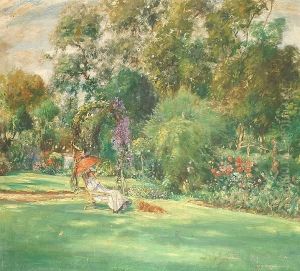William Brown Macdougall Paintings
William Brown MacDougall, born in 1868 in Edinburgh, Scotland, was a distinguished artist and illustrator whose work spans the realms of illustration, engraving, and stained glass design. He emerged during a time of artistic flourishing in the United Kingdom, particularly within the Arts and Crafts Movement, which sought to revive traditional craftsmanship amidst the industrialization of the 19th century. MacDougall's contributions, especially in book illustration and wood engraving, are noted for their intricate detail and the influence of Celtic and Norse motifs, aligning him with the broader aesthetic preferences of his time.
MacDougall was educated at the Edinburgh School of Art, where he honed his skills and developed a keen interest in the artistic styles that would define his career. His work is characterized by a unique blend of medieval and modern influences, which he adeptly incorporated into both his illustrations and stained glass designs. Throughout his career, MacDougall collaborated with notable contemporaries, including Patrick Geddes, with whom he shared a vision of integrating art into everyday life as part of a broader societal improvement.
One of MacDougall's most significant contributions to the art world was his role in the revival of woodblock printing in Britain. He was a master of the medium, using it to produce works that were remarkable for their expressiveness and technical precision. His illustrations for books such as James Thomson's "The City of Dreadful Night" and Sir Walter Scott's works are celebrated examples of his skill and artistic vision.
MacDougall's stained glass works are less well-documented but equally significant, demonstrating his versatility and commitment to applying his artistic principles across different media. His designs often featured the same intricate detailing and mythological themes found in his prints, contributing to the aesthetic and spiritual enrichment of the spaces they inhabited.
William Brown MacDougall's death in 1936 marked the end of a career that had significantly impacted the visual arts in Britain. His legacy is one of artistic excellence and innovation, rooted in a deep respect for tradition but always looking forward to the possibilities of new techniques and materials. Today, his works are held in various collections and continue to be studied for their contribution to the Arts and Crafts Movement and the broader narrative of Scottish and British art.
